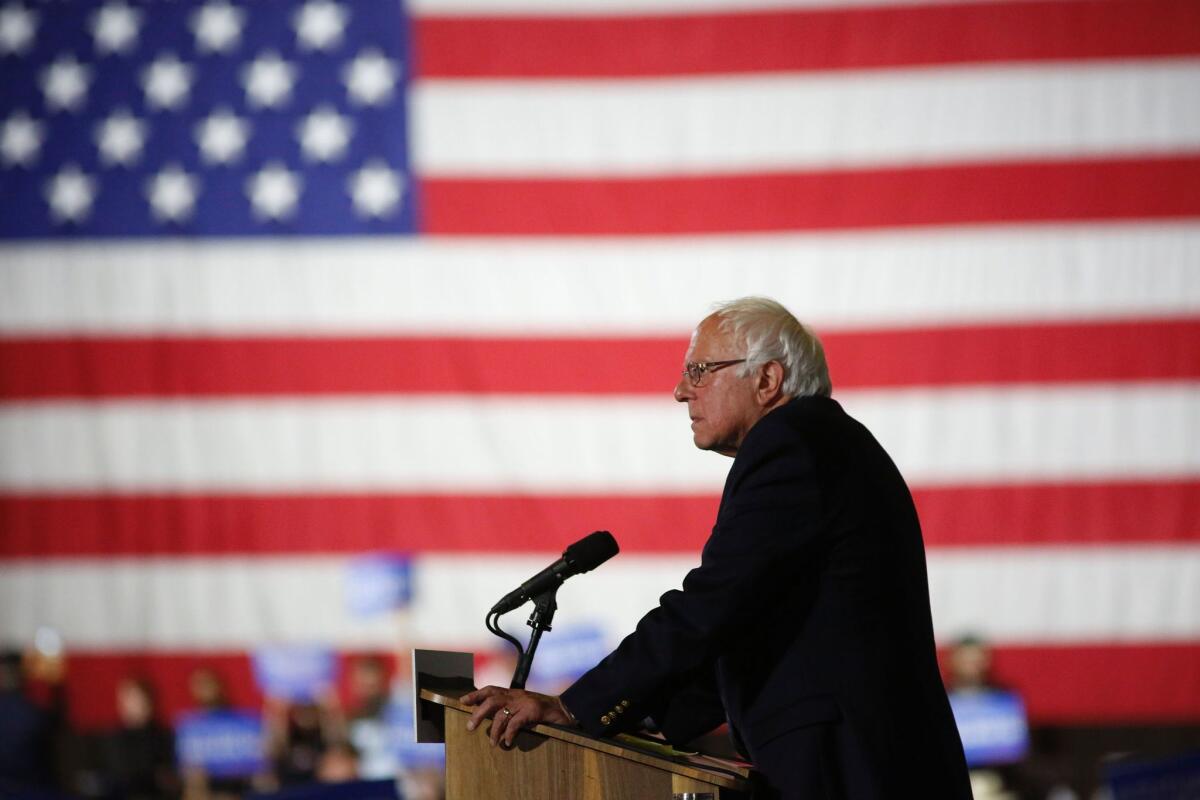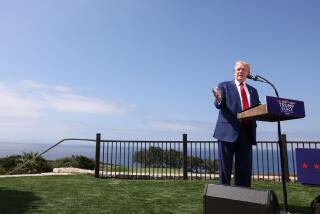Analysis: Sanders voters in California look for concessions from Clinton, but most will support her — if reluctantly

Vermont Sen. Bernie Sanders speaks to supporters in Santa Monica on June 7, the night of the California primary.
More than 6 in 10 Bernie Sanders voters in California already have decided to side with Hillary Clinton in the fall — albeit most of them with reservations — and many of the rest said they might support her if she adopted some of his policies and received his endorsement, according to a new statewide poll.
The findings from a USC Dornsife/Los Angeles Times postelection survey suggest a path to unity, however fraught, for Democrats nationally as the party attempts to bind the wounds of the lengthy primary battle.
The poll also offers no sign of Republicans being competitive in the state in the fall. Even with only partial support so far from Sanders’ voters, Clinton defeats presumptive GOP nominee Donald Trump, who has vowed to contest California, by 30 percentage points in a projected general-election matchup.
See the most-read stories this hour >>
Sanders voters who said they would not back Clinton offered several possibilities for what might sway them.
About 1 in 5 Sanders backers said they might vote for Clinton if she adopted Sanders’ views on political reform. During the campaign, Sanders stressed refusing to raise money through super-PACs and getting rid of the Democratic Party’s system of superdelegates: party officers and elected officials who have a vote in the selection of a nomination.
This year the overwhelming majority of superdelegates sided with Clinton, although she also won more pledged delegates in state primaries and caucuses.
Almost 1 in 5 Sanders voters said they might be swayed if Clinton adopted Sanders’ economic platform, which includes breaking up the nation’s big banks and raising the minimum wage to $15 an hour.
The same proportion said they might be affected by Sanders’ endorsement. Far fewer said they would be affected by backing from President Obama or Massachusetts Sen. Elizabeth Warren.
But 25% of Sanders’ voters – especially those who were male and independents, not registered Democrats – said nothing could persuade them to side with Clinton.
The former secretary of State, who defeated Barack Obama in the 2008 primary here by more than 8 points, currently leads Sanders in California by just over 12 points. As of Friday evening, state officials said about 2.4 million ballots remained to be counted, not all in the Democratic primary. Counties have until July 8 to complete the count.
The USC/LA Times poll questioned 1,553 registered voters from June 7-10, including 1,264 who said they voted in the June 7 primary. The poll was conducted online by SurveyMonkey for the USC Dornsife College of Letters, Arts and Sciences and the Los Angeles Times. It has a confidence interval of 4 points in either direction for those who cast ballots.
In keeping with the entire primary race, the Democratic contest in California was marked by significant age and gender gaps.
The poll found Sanders won by 60 points among those younger than 30, much as he has in other states. But under-30 voters made up only a small percentage of those casting ballots. Clinton won among those older than 30, and her advantage was particularly acute among those older than 50; she defeated Sanders by 38 points among those between ages 50 and 64, and by 37 points among those older than 65.
Her advantage among women was similarly crucial to her easy win. She won 60% of female voters, most of them older, to Sanders’ 39%. By contrast, the two were split among male voters, with 48% for Clinton and 50% for Sanders.
Another result seen in nearly every state this year proved true in California: a deep division between Democrats and nonpartisan voters allowed to cast Democratic ballots. As he has elsewhere, Sanders carried nonpartisan voters by more than 2 to 1. Clinton won Democrats, 62% to 37%. Unfortunately for Sanders, party members were twice as prominent in the June 7 electorate as independents.
Sanders did make inroads, however, among one voter group much sought after by Clinton: Latino voters. Sanders appeared to have won a narrow majority of Latinos, probably driven by his success among young voters. (The poll’s sample of Latino Democrats was too small to say definitively.) Clinton won white voters and prevailed overwhelmingly among black voters.
All told, about half of Sanders’ voters said that they would cast a ballot for Clinton in November “but with reservations.” An additional 16% said they would vote for her enthusiastically.
As with the overall vote, there were strong gender and party divisions.
FULL COVERAGE: Democrats campaign in California>>
Women who supported Sanders were far more likely than their male counterparts to be willing to vote for Clinton; all told, 73% of women and 57% of men said they’d side with her in November. Thirty percent of men said they would vote for Trump (7%) or another candidate (23%), compared with a combined 22% of women who said they would vote for someone else.
Only 4% of women who had voted for Sanders said they would withhold their vote; 12% of men said they planned not to vote.
Nearly 8 in 10 self-identified Democrats who had voted for Sanders said they would vote for Clinton.
Among the independents drawn to Sanders, the verdict was, at least for now, different. Just over 4 in 10 were committed to the presumptive Democratic nominee, and only 3% said they would back her enthusiastically.
Winning the support of Sanders’ voters in California and nationally poses some complicated problems for Clinton.
Much as the Sanders’ voters would like to see Clinton adopt the Vermont senator’s proposals, doing so on an assortment of issues could resurrect one of the complaints that many voters have long had about her: that she has changed her views for political benefit.
So far, Clinton has emphasized the positions she generally shares with Sanders even if they aren’t entirely in tandem. On the minimum wage, for example, she favors a $12-an-hour raise at the federal level and would encourage states to boost it to $15 an hour, while Sanders wants a $15 rate to be applied nationally. Clinton’s pitch now avoids those details to stipulate that both of them want the minimum wage raised.
Trump, she notes, opposes a minimum wage increase and earlier in the campaign year said he thought wages in the U.S. were too high. That highlights the contrast she has been drawing and the biggest advantage Clinton has here as nationally: her competitor.
Trump’s recent criticism of a federal judge who he declared was biased against him because he is “Mexican” — actually Judge Gonzalo Curiel was born in Indiana to parents of Mexican heritage — has further hurt Trump’s standing among voters here. Curiel is hearing a case brought against Trump by customers at the former Trump University, a real estate school.
Almost two-thirds of all voters said they “strongly disagreed” with Trump’s treatment of the judge, and an additional 10% disagreed somewhat. Only 10% of voters strongly agreed with Trump. Yet a majority of Republicans – 55% – said they agreed with Trump, and 42% disagreed.
More than half of California’s June voters — 54% -- said the controversy made them less likely to support Trump. Only 6% said it made them more likely to back him; again, that was a position mostly held by Republicans.
But for many California voters, the controversy was moot; they already have decided to vote for Clinton, who led Trump among poll respondents, 61% to 31%.
Even among groups who are not always in her corner, Clinton did well. She won over men, 53% to 37%, in addition to winning women by 45 points. She won young voters, who had abandoned her in the primary, 73% to 19%. She won 54% of white voters, the most Republican group among the state’s racial and ethnic blocs. She also won more than 1 in 10 Republican voters.
Twitter: @cathleendecker. For more on politics, go to latimes.com/decker and subscribe to the free daily newsletter.
ALSO:
California’s presidential party is over, and here are some lessons
Hillary Clinton up, Donald Trump down in a week that flipped the presidential race
Clinton, finally breaking one glass ceiling, ready for a gender battle with Donald Trump
Updates on California politics
Live coverage from the campaign trail
UPDATES:
10:12 a.m.: This article was updated to clarify that the question about what steps Clinton could take to appeal to Sanders’ backers was asked of all those who voted for Sanders.
This article was originally published at 3 a.m.
More to Read
Get the L.A. Times Politics newsletter
Deeply reported insights into legislation, politics and policy from Sacramento, Washington and beyond. In your inbox three times per week.
You may occasionally receive promotional content from the Los Angeles Times.











